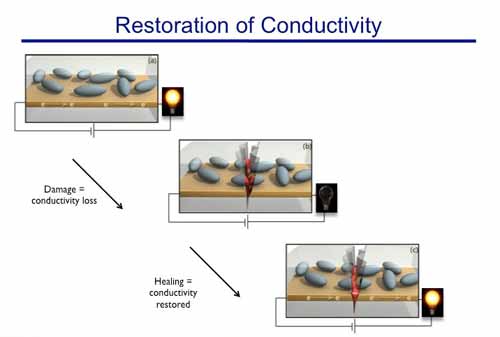Self-healing electronics could work longer and reduce waste
22 Dec 2011
When one tiny circuit within an integrated chip cracks or fails, the whole chip – or even the whole device – is a loss. But what if it could fix itself, and fix itself so fast that the user never knew there was a problem?
A team of University of Illinois engineers has developed a self-healing system that restores electrical conductivity to a cracked circuit in less time than it takes to blink. Led by aerospace engineering professor Scott White and materials science and engineering professor Nancy Sottos, the researchers published their results in the journal Advanced Materials.
''It simplifies the system,'' said chemistry professor Jeffrey Moore, a co-author of the paper. ''Rather than having to build in redundancies or to build in a sensory diagnostics system, this material is designed to take care of the problem itself.''
As electronic devices are evolving to perform more sophisticated tasks, manufacturers are packing as much density onto a chip as possible. However, such density compounds reliability problems, such as failure stemming from fluctuating temperature cycles as the device operates or fatigue. A failure at any point in the circuit can shut down the whole device.

''In general there's not much avenue for manual repair,'' Sottos said. ''Sometimes you just can't get to the inside. In a multilayer integrated circuit, there's no opening it up. Normally you just replace the whole chip. It's true for a battery too. You can't pull a battery apart and try to find the source of the failure.''
Most consumer devices are meant to be replaced with some frequency, adding to electronic waste issues, but in many important applications – such as instruments or vehicles for space or military functions – electrical failures cannot be replaced or repaired.
The Illinois team previously developed a system for self-healing polymer materials and decided to adapt their technique for conductive systems. They dispersed tiny microcapsules, as small as 10 microns in diameter, on top of a gold line functioning as a circuit. As a crack propagates, the microcapsules break open and release the liquid metal contained inside. The liquid metal fills in the gap in the circuit, restoring electrical flow.
''What's really cool about this paper is it's the first example of taking the microcapsule-based healing approach and applying it to a new function,'' White said. ''Everything prior to this has been on structural repair. This is on conductivity restoration. It shows the concept translates to other things as well.''
A failure interrupts current for mere microseconds as the liquid metal immediately fills the crack. The researchers demonstrated that 90 per cent of their samples healed to 99 per cent of original conductivity, even with a small amount of microcapsules.
The self-healing system also has the advantages of being localised and autonomous. Only the microcapsules that a crack intercepts are opened, so repair only takes place at the point of damage. Furthermore, it requires no human intervention or diagnostics, a boon for applications where accessing a break for repair is impossible, such as a battery, or finding the source of a failure is difficult, such as an air- or spacecraft.
''In an aircraft, especially a defense-based aircraft, there are miles and miles of conductive wire,'' Sottos said. ''You don't often know where the break occurs. The autonomous part is nice – it knows where it broke, even if we don't.''
Next, the researchers plan to further refine their system and explore other possibilities for using microcapsules to control conductivity. They are particularly interested in applying the microcapsule-based self-healing system to batteries, improving their safety and longevity.
This research was supported as part of the Center for Electrical Energy Storage, an Energy Frontier Research Center funded by the US Department of Energy, Office of Science. Moore, Sottos and White are also affiliated with the Beckman Institute for Advanced Science and Technology at the U. of I. Co-authors of the paper included postdoctoral researchers Benjamin Blaiszik and Sharlotte Kramer and graduate students Martha Grady and David McIlroy.



.webp)



























